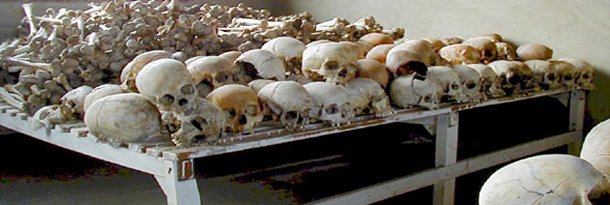|
Rwanda History |
Rwanda History |
Rwanda History | Rwanda History |
For information, videos and photos of the African nation of Rwanda, check out our Rwanda pages.
More >

In 1959 the Hutu rebelled and sent the Tutsi King Kigeri V into exile in Uganda proclaiming a Hutu republic in 1962 with Gregoire Kayibanda, a young Hutu journalist and Chief Editor of the Catholic newspaper Kinyamateka, as president.
It is this symbiotic relationship between Rwanda and Burundi and their Hutu and Tutsi tribes that help to understand events from the late 1960s through to the genocide of 1994. In Rwanda in 1967 there was yet another anti-Tutsi surge with Tutsi murdered and their carcasses disposed of in rivers whilst in 1972 the Tutsi army in Burundi wiped out nearly the entire educated Hutu class in Burundi, some 200,000 people. In 1973 President Kayibanda of Rwanda was ousted in military coup led by Juvenal Habyarimana, the defence minister in his government, who held elections in 1978 under a new constitution in which Habyarimana was elected president. Under the new regime suppression of the Tutsi continued unabated. Simultaneously the oppression of Hutus in neighbouring Burundi gathered pace and forces of the mainly Tutsi Rwandan Patriotic Front (RPF) invaded Rwanda from Uganda in 1990, however talks ensued and Habyarimana signed an agreement with the Tutsis signally a power sharing deal known as the Arusha Accords in an effort to bring some peace between the warring factions. However the relationship between the two ran too deep with too much hatred. A collapse in coffee prices in 1989 left hundreds of thousands of Rwandan farmers destitute whilst the Tutsi populated RDF stepped up its campaign against the Hutu Rwandan army the following year whilst Burundi's own army continued to slaughter Burundi Hutu many of who fled into southern Rwanada awaiting revenge on the Tutsi. With relations on edge it didn't take much for the full fury of racial hatred to erupt and the trigger came when President Habyarimana of Rwanda and the Burundian president, Cyprien Ntaryamira, were assassinated when a rocket shot down their plane over Kigali airport in 1994 triggering what is now known as the Rwanda genocide. In all likelihood this assassination was carried out by Hutu extremists within Rwanda who genuinely believed that the Tutsi wished to enslave them. The extremists saw Habyarimana and others as collaborators with the Tutsi and rather than accept reform they believed that the only solution was to eradicate all Tutsi from Rwanda like pest control. The genocide narrative is explored here. |





 Many Tutsi also fled to Uganda as the Belgians failed to protect them from Hutu violence however they did not settle and were often treated cruelly by the regimes of Milton Obote and Idi Amin as they watched events back home from the border. In neighbouring Burundi, the opposite had taken place with the Tutsi suppressing the Hutu upon independence and in 1963 attacking Rwanda from there, however in this incursion many Tutsi were killed by Hutu Rwandans.
Many Tutsi also fled to Uganda as the Belgians failed to protect them from Hutu violence however they did not settle and were often treated cruelly by the regimes of Milton Obote and Idi Amin as they watched events back home from the border. In neighbouring Burundi, the opposite had taken place with the Tutsi suppressing the Hutu upon independence and in 1963 attacking Rwanda from there, however in this incursion many Tutsi were killed by Hutu Rwandans.


